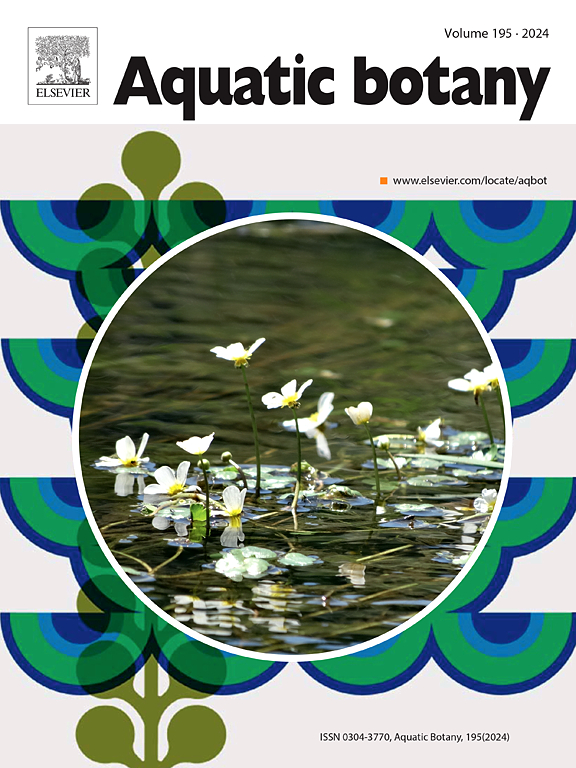遗传变异不支持在温带欧亚大陆的古赞尼切利亚复合体内的物种划分
IF 2.6
4区 生物学
Q2 MARINE & FRESHWATER BIOLOGY
引用次数: 0
摘要
生物多样性研究在很大程度上依赖于可靠的物种鉴定。palustris复合体内的形态变异性相当低,这导致已发表的诊断特征存在显著差异。该复合体在欧亚尺度上的遗传变异性尚不清楚。此外,还报道了Zannichellia区的特有种,但其分类地位尚未得到遗传学上的证实。因此,我们的目的是研究提出的诊断性状和遗传变异(核糖体DNA (ITS)和质体DNA (trnH-psbA)标记)在全区域范围内的Z. palustris复合体大量材料上的变化。抽样主要包括前苏联;来自北美、以色列、土耳其、中国、蒙古和西欧的一些样本也进行了研究。我们没有在复合体中发现任何不同的形态。单倍型和核糖型也没有形态分化。因此,我们无法在古竹复合体中区分任何物种。堪察加特有分类群(Z. komarovii)和伏尔加河下游特有分类群(Z. clausii)也没有遗传分化。为了进一步明确该复合体的分类,有必要进一步开展基于低拷贝核基因分析和标本倍性评估的研究。本文章由计算机程序翻译,如有差异,请以英文原文为准。
Genetic variability does not support species delimitation within the Zannichellia palustris complex in temperate Eurasia
Biodiversity researches rely heavily on trustworthy species identification. Morphological variability within the Zannichellia palustris complex is quite low, which results in significant differences in the published diagnostic characteristics. Genetic variability of the complex in Eurasian scale remains unclear. Endemic species in the section Zannichellia also were described but their taxonomic status has not been confirmed genetically. Thus, we aimed to study variation of the proposed diagnostic traits and genetic variability (nuclear ribosomal DNA (ITS) and plastid DNA (trnH-psbA) markers) on mass material of the Z. palustris complex on the area-wide scale. The sampling primarily covered the former USSR; some samples from North America, Israel, Turkey, China, Mongolia, and West Europe were also studied. We did not manage to reveal any distinct morphotypes within the complex. There was also no morphological differentiation of haplotypes and ribotypes. Thus, we were not able to distinguish any species within Z. palustris complex. Endemic taxa from Kamchatka (Z. komarovii) and from the Lower Volga (Z. clausii) also were not differentiated genetically. Additional studies based on analysis of low-copy nuclear genes along with an assessment of the ploidy of the specimens is necessary to further clarify the taxonomy of the complex.
求助全文
通过发布文献求助,成功后即可免费获取论文全文。
去求助
来源期刊

Aquatic Botany
生物-海洋与淡水生物学
CiteScore
3.80
自引率
5.60%
发文量
70
审稿时长
6 months
期刊介绍:
Aquatic Botany offers a platform for papers relevant to a broad international readership on fundamental and applied aspects of marine and freshwater macroscopic plants in a context of ecology or environmental biology. This includes molecular, biochemical and physiological aspects of macroscopic aquatic plants as well as the classification, structure, function, dynamics and ecological interactions in plant-dominated aquatic communities and ecosystems. It is an outlet for papers dealing with research on the consequences of disturbance and stressors (e.g. environmental fluctuations and climate change, pollution, grazing and pathogens), use and management of aquatic plants (plant production and decomposition, commercial harvest, plant control) and the conservation of aquatic plant communities (breeding, transplantation and restoration). Specialized publications on certain rare taxa or papers on aquatic macroscopic plants from under-represented regions in the world can also find their place, subject to editor evaluation. Studies on fungi or microalgae will remain outside the scope of Aquatic Botany.
 求助内容:
求助内容: 应助结果提醒方式:
应助结果提醒方式:


